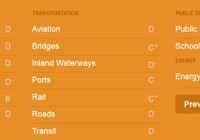U.S. Infrastructure Is Aging And In Dire Need Of A Refresh
By Mary-Lynn Cesar New York Governor Andrew Cuomo and Vice President Joe Biden made a joint appearance Monday afternoon to announce major infrastructure upgrades to LaGuardia Airport. Adding to Biden’s ” third-world country ” description of LaGuardia, Cuomo said the airport was ” un-New York ” and revealed that construction on a new LaGuardia airport will begin next year. The project is expected to cost the Port Authority of NY & NJ $4 billion . LaGuardia is but one example of US infrastructure that badly needs an update. There are the Hudson River rail tunnels -which service Amtrak and NJ Transit trains between New York and New Jersey-the Albion River Bridge in coastal California and the nation’s wastewater and drinking water systems , to name a few. According to the American Society of Civil Engineers’ 2013 report card , which assesses and grades all segments of US infrastructure, things are in poor shape. The overall grade was a D+, and an estimated $3.6 trillion would need to be invested in infrastructure by 2020 to improve the situation. Per Governing.com, the five largest infrastructure projects currently underway in the US are the Dulles International Airport Corridor Metrorail Project, Otay Mesa East port facility construction, modernization of O’Hare International Airport, expansion of the Crescent Corridor freight rail network and replacing the Alaskan Way Viaduct. Combined the projects will cost $21.4 billion. While there are trillions that need to be invested in US infrastructure, the fact remains that they haven’t been yet. Perhaps this is why infrastructure ETFs with exposure to potential US projects haven’t been performing well. In fact, all of the following funds have underperformed the market on a monthly quarterly and year-to-date basis. Could the LaGuardia airport project help some of these ETFs turn things around? Deutsche X-trackers S&P Hedged Global Infrastructure ETF (NYSEARCA: DBIF ) ( Earnings , Analysts , Financials ): Seeks to track the performance of equity securities of infrastructure issuers in developed markets. Net assets under management: $3.53M, most recent closing price: $23.77. The fund has underperformed the market by -3.22% over the last month, -5.54% over the last quarter and -4.66% since the beginning of the year. SPDR S&P Global Infrastructure ETF (NYSEARCA: GII ) ( Earnings , Analysts , Financials ): Seeks to reflect the stock performance of companies within the infrastructure industry, principally those engaged in management, ownership and operation of infrastructure and utility assets. Net assets under management: $97.83M, most recent closing price: $46.08. The fund has underperformed the market by -4.46% over the last month, -8.40% over the last quarter and -3.64% since the beginning of the year. iShares Global Infrastructure ETF (NYSEARCA: IGF ) ( Earnings , Analysts , Financials ): Seeks to replicate the S&P Global Infrastructure Index. Net assets under management: $1.20B, most recent closing price: $40.05. The fund has underperformed the market by -4.09% over the last month, -8.00% over the last quarter and -3.79% since the beginning of the year. ProShares DJ Brookfield Global Infrastructure ET (NYSEARCA: TOLZ ) ( Earnings , Analysts , Financials ): Seeks to replicate Dow Jones Brookfield Global Infrastructure Composite Index. Net assets under management: $25.99M, most recent closing price: $40.55. The fund has underperformed the market by -5.60% over the last month, -10.04% over the last quarter and -7.10% since the beginning of the year. (Monthly return data sourced from Zacks Investment Research. Assets data sourced from Yahoo! Finance. All other data sourced from FINVIZ.) Share this article with a colleague
